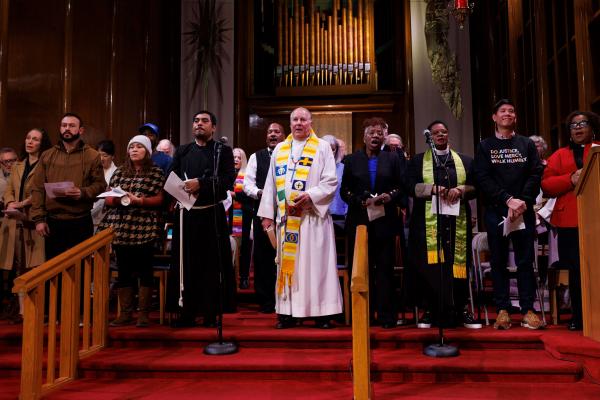What does it take to survive the wrath of gods? This has been a perennial question for Star Lord, Rocket, Gamora, Drax, Groot, Mantis, Nebula, and the others who have found themselves drawn into the orbit of the Guardians of the Galaxy. In Vol. 3, the Guardians face a being consumed by achieving perfection and known as the High Evolutionary (Chukwudi Iwuji giving a delightfully unhinged performance). The High Evolutionary’s pursuit of perfection is destructive, the opposite of the way the God of the Bible pursues perfection. Writer/director James Gunn illustrates this by spinning the long story of the Bible in reverse: He begins with apocalypse, moves through flood, and ends with creation.
Unlike previous Guardians films, the stakes in Vol. 3 are smaller and more personal. After an attack leaves Rocket critically wounded, the Guardians realize they can’t operate on him. Whoever created Rocket — transforming him from a common Earth raccoon to a snarky, weapons-obsessed sentient — ensured anyone who tried to tamper with their proprietary technology would destroy Rocket instead. That “whoever” turns out to be the High Evolutionary, whose manipulation of Rocket was part of his quest to create a perfect planet, one he named “Counter-Earth.” If they have any hope of saving their friend, the Guardians must seek out the High Evolutionary in his Eden.
When the Guardians arrive on Counter-Earth, they find it to be far from Edenic: classism, crime, and substance abuse run rampant in just the few minutes we glimpse one corner of this supposed paradise. When faced with the reality of his failure to manufacture utopia, the High Evolutionary abandons his creation, destroying the world in fire. It’s not hard to see the book of Revelation played out as earthquakes swallow houses, fire falls from the sky, and everyone weeps.
The destruction of Counter-Earth confirms what we’ve suspected about the High Evolutionary: He does not care about his creations. Rocket and his friends are nothing more than experiments he’s conducted on the way to his goal of perfection.
Such a god (little ‘g’!) is a far cry from the God of scripture, who creates the world by loving invitation, then creates humanity to be partners in that creation. The High Evolutionary’s casual disregard for the world(s) looks a lot like the read of Genesis 1:28 pundit Ann Coulter employed when she said, “God gave us the Earth. We have dominion over the plants, the animals, the trees. God said, ‘Earth is yours. Take it. Rape it. It’s yours.’” But this is a shallow — and dangerous — read of scripture.
Genesis 1 is a riff on the Babylonian creation epic, where Marduk creates the world through violence: He literally slays the goddess of the deep, mutilates her body, and forms the world from her corpse. In contrast, YHWH, the god of Genesis, fights no one. Instead, YHWH offers loving invitations of, “Let there be.” Humans rule in YHWH’s image, and so subdue and have dominion not through Marduk’s forceful violence or unjust exploitation, but through YHWH’s loving invitation and partnership.
So too, the God revealed to us in Revelation (specifically through the person and work of Jesus) is not one who destroys capriciously. Rather, in Revelation, God works to preserve the innocent, to avenge those martyred because of their faithfulness, and wages war against the forces of evil. What’s destroyed in Revelation are the systems of injustice and the forces that empower them. Most importantly, it’s God’s own self-sacrifice (again, in the person of Jesus as the “always-slaughtered Lamb”) that reveals how God wages this war.
Such a vision of self-sacrifice doesn’t seem far from Gunn’s mind as the film moves from apocalypse to ark-opalypse.
But before we dive into the Guardians’ Ark-opalypse, here’s a quick refresher on the primordial history of the flood as recorded in the Bible. The flood narrative stands near the end of Genesis’ prehistoric prologue. From the beginning, rather than serving as faithful stewards of God’s good creation, humanity has chosen to live on their own terms, to function as though there is no god. This has led to innumerable injustices and violence, with the world falling into a sort of death spiral. By Genesis 6, God has repented of creating humanity and decides to let us have what we want — a world without God’s loving sustenance. After instructing Noah to build an ark and preserve two of each animal, God undoes creation, opening up the windows of the dome of the sky and the fountains of the deep that God had closed up on day two. The primordial waters of chaos rush back into creation, unmaking everything. By the end of chapter 7, the world looks as it did at the beginning of chapter 1, save for one little ark bobbing on the surface of the deep.
The flood story sets an important precedent for understanding God’s wrath throughout scripture. We experience God’s wrath when God gives us what we want. For the prophets, this looked like God giving the people over to the empires they trusted more than God. Giving them a king when God’s leadership wasn’t sufficient (1 Samuel 8). And in Genesis 7, it looked like removing the carefully drawn boundaries that made the space in primordial waters in which life could flourish.
But whether in the ark or among the exiles, God repeatedly spared the innocent and the faithful, those who were victims of the injustice consuming the world.
Spoilers follow
Having already survived apocalypse by fire, the Guardians must face the High Evolutionary on his ship. They find it stuffed to the brim with his experiments — primarily children and a vast assortment of Earth critters (including raccoons). The thrilling final sequence is a massive jailbreak that sees the Guardians working to rescue everyone, including the animals, from a dying ship. Images of the flood story from Genesis 6-9 tread close to the film’s surface, reminding us this is yet another apocalypse.
But we’re moving backwards — just in time for Star Lord to die.
Star Lord is last off the Ark, and he doesn’t quite make it. The rest of his found-family watch in horror as ice encapsulates him and the light goes out of his eyes. But just then, Adam steps in. This Adam — Adam Warlock — was actually created to destroy the Guardians, but after witnessing their goodness, he has a change of heart. In a dramatic sequence, Adam reaches for Star Lord in a pose that imitates Michelangelo’s The Creation of Adam on the ceiling of the Sistine Chapel. And just like that, Vol. 3 has moved from apocalypse to flood to creation. Now all that’s left to do is dance — literally.
Star Lord is absent, having returned to Earth to face his past. But a dance sequence continues without him in a very real way because his childlike joy and self-sacrifice have created a family out of disparate outcasts, a family that can survive any kind of apocalypse because they’ve been bound together by the joy of new creation. And best of all, their family has room enough for anyone and everyone.
In working to describe how YHWH is different from the Roman gods, early theologians reached for the metaphor of dance. Rather than a top-down hierarchy where YHWH lords godly power over creation, the Father, Son, and Spirit exist in an eternal movement of self-giving love, emptying themselves into each other and receiving from each other. So too, they invite creation to join in this movement of giving and receiving, responding to each other as in a dance.
Such joy and abandon couldn’t be further from the spirit of the High Evolutionary. His drive for perfection doesn’t have room for play, for joy. The dance of the Guardians family is the perfect ending. I’m sure it’s not what Gunn intended, but I don’t know that I’ve seen a more compelling image of the church on the silver screen.
Got something to say about what you're reading? We value your feedback!







